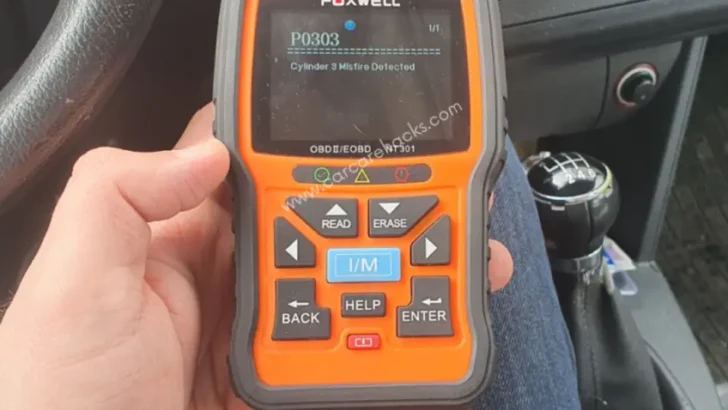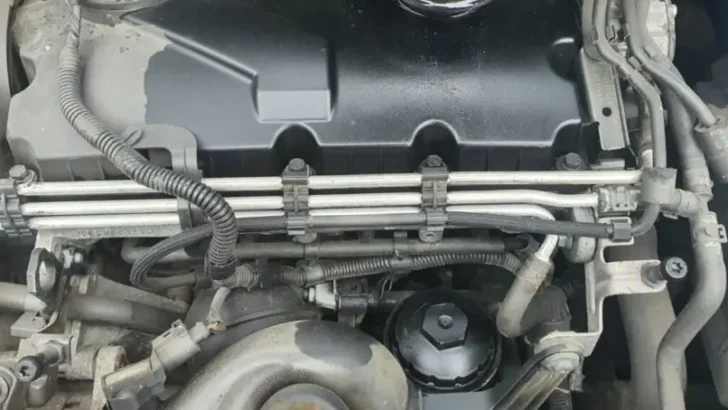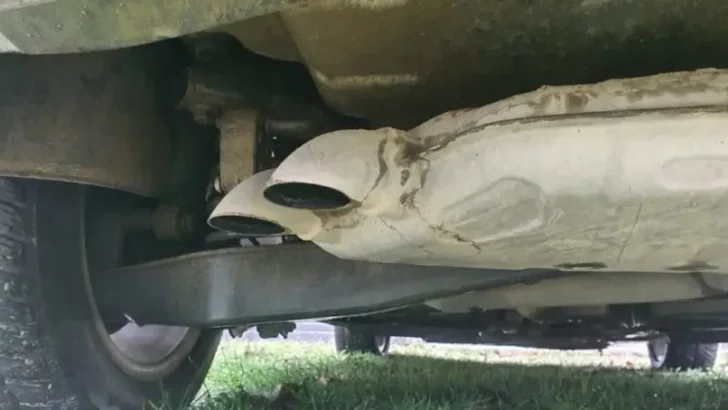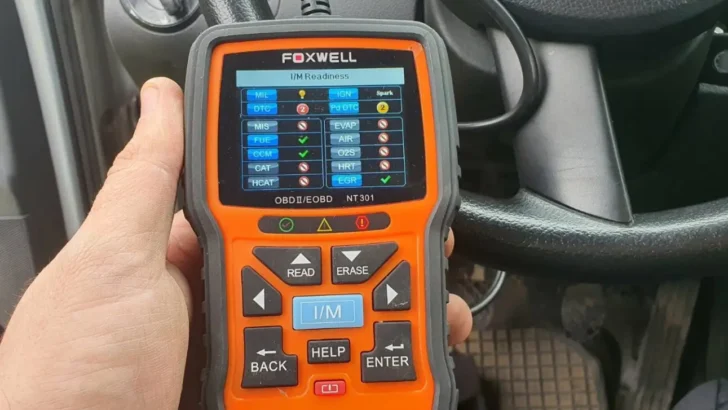P0303 code is an OBD-II trouble code that stands for “Cylinder 3 Misfire Detected.” This code also appears alongside other misfire codes and lean/rich condition codes.
In this article, I will be talking about the P0303 trouble code, its symptoms, causes, and how to fix it.
What Does The P0303 Code Mean?

The P0303 trouble code means that there are multiple engine misfires in cylinder 3. A misfire is the inability of one or more cylinders to produce adequate combustion. This is why, DTC P0303 would indicate a recurring lack of combustion on cylinder 3.
An engine’s powertrain control module (PCM) detects misfires and logs freeze-frame data of the incident in question. Via the examination of data supplied by the crankshaft position sensor, the PCM of a motor identifies such misfires. A relative decrease in crank speed during the power stroke of a particular cylinder might indicate a misfire.
When this occurrence occurs numerous times, a P030(X) code is recorded, where (X) represents the number of the cylinder where the misfire was identified. A check engine light is then displayed on the instrument cluster of the concerned vehicle to alert the driver.
Which Models Are Affected By The P0303 Code
| Make | Affected By P0303 Code |
|---|---|
| Toyota | Yes |
| Nissan | Yes |
| Chevrolet | Yes |
| BMW | Yes |
| Audi | Yes |
| Buick | Yes |
| Mercedes | Yes |
| GMC | Yes |
| Suzuki | Yes |
| Tata | Yes |
| Lexus | Yes |
| Mazda | Yes |
| Mitsubishi | Yes |
| Kia | Yes |
| Jeep | Yes |
| Fiat | Yes |
| Honda | Yes |
| Hyundai | Yes |
| Opel | Yes |
| Ford | Yes |
| Fiat | Yes |
| Peugeot | Yes |
What Are The Possible Causes of the P0303 Code?

Misfires in cylinder 3 may be caused by a variety of reasons such as a defective ignition system, fuel system, or internal engine failure. Often, this is caused by defective or worn-out spark plug coil packs, particularly if it has been a while since your last tune-up.
Here are the possible causes of the P0303 trouble code:
- Defective or worn spark plugs
- Defective spark plug wires or ignition coils
- Faulty fuel injectors
- Faulty distributor cap
- Leaks from the vacuum
- Faulty camshaft sensor
- Faulty crankshaft sensor
- The head gasket is leaking or blown
- The engine compression is low
- The fuel compression is low
- Poor fuel quality
- Engine timing is off
What Are The Common Symptoms of The P0303 Code?

Many symptoms frequently accompany the existence of a P0303 diagnostic trouble code. Even though these symptoms frequently vary from case to case, certain symptoms seem to be significantly more widespread than others.
Here are the most common symptoms of the P0303 trouble code:
- The check engine light
- The engine is running rough and shaking
- Vehicle jerking/hesitations when accelerating
- Poor fuel economy
- Fuel smell from the exhaust
- The engine has lack power
Is It Safe To Drive With a P0303 Code?
No, driving with the P0303 trouble code is very critical. Stop your vehicle immediately if the engine warning light is illuminated and the PCM reads this OBD-II trouble code.
Since the engine of your vehicle relies on the proper operation of its cylinders, cylinder misfires could cause costly internal engine damage.
In addition, if the P0303 code is not identified and rectified as soon as possible, it could cause ignition failure, catalytic converter damage, and unsafe driving conditions.
How To Diagnose The P0303 Code

Here is how to diagnose the P0303 trouble code:
- Gather the trouble codes with your OBD-II scanner and use freeze frame data to determine the issue. Continue the troubleshooting based on any further trouble codes you discover.
- Clear the codes
- Drive the vehicle to determine which codes are returned.
- Check the spark plug, ignition coil, wire, or coil pack on cylinder 3 for damage or wear. Replace as needed. You can try moving the spark plug and ignition coil to a different cylinder to see if you obtain a trouble code on that cylinder instead; if so, you must replace the spark plugs and ignition coil.
- Determine if the intake system has a vacuum leak.
- If this is not the issue or if the code remains, you must inspect the fuel injectors.
- If you have an older vehicle, you may also need to inspect the distributor cap and ignition cables.
- Beyond this, a cylinder 3 compression test will be required.
- Inspect the camshaft timing and, if necessary, inspect the timing belt or shaft.
- If the diagnostics reveal nothing further, it is possible that the PCM is defective and must be replaced. With this issue, you will certainly encounter further incorrect codes or issues.
Most Common Mistakes When Diagnosing The P0303 Code
Typically, the spark plugs, ignition coils, wires, or coil pack will be responsible for the misfire. But, you should never presume that this is the issue before conducting the diagnostic steps we discuss. Before replacing it, you must visually inspect the plugs, wires, coils, and coil pack.
If these parts appear to be in good condition, you must move on to other potential problem-causing parts, such as the fuel injectors or valves. You must also conduct a compression test. In addition, if there are any more trouble codes, these may assist you to narrow down the issue.
How Much Does It Cost To Repair P0303 Code?
Following a correct diagnosis, the P0303 trouble code may require one or more of the following repairs to resolve the underlying problem. These prices are inclusive of parts and labor and are based on national averages. Your pricing may vary based on your location and vehicle type.
- Spark plugs replacement: $66-$250
- Ignition coils replacement: $230-$640
- Spark plug wires replacement: $180-$240
- Fuel injectors replacement: $350-$850
- Fuel pump replacement: $400-$1200
- Fixing vacuum leak: $100-$1000
- Fuel pressure regulator replacement: $200-$400
| Make | P0303 Code | Repair Cost |
|---|---|---|
| Toyota | Yes | $66 – $1200 |
| Nissan | Yes | $66 – $1200 |
| Chevrolet | Yes | $66 – $1200 |
| BMW | Yes | $66 – $1200 |
| Audi | Yes | $66 – $1200 |
| Buick | Yes | $66 – $1200 |
| Mercedes | Yes | $66 – $1200 |
| GMC | Yes | $66 – $1200 |
| Suzuki | Yes | $66 – $1200 |
| Tata | Yes | $66 – $1200 |
| Lexus | Yes | $66 – $1200 |
| Mazda | Yes | $66 – $1200 |
| Mitsubishi | Yes | $66 – $1200 |
| Kia | Yes | $66 – $1200 |
| Jeep | Yes | $66 – $1200 |
| Fiat | Yes | $66 – $1200 |
| Honda | Yes | $66 – $1200 |
| Hyundai | Yes | $66 – $1200 |
| Opel | Yes | $66 – $1200 |
| Ford | Yes | $66 – $1200 |
| Fiat | Yes | $66 – $1200 |
| Peugeot | Yes | $66 – $1200 |
What Repairs Can Fix The P0303 Code?
Repairs that can fix the P0303 trouble code are:
- Replace the spark plugs
- Replace the spark plug wires or ignition coils
- Change the fuel injectors
- Change the distributor cap
- Repair the leaks from the vacuum
- Repair the leaking head gasket
- Replace the camshaft sensor
- Replace the crankshaft sensor
How To Fix The P0303 Code
Here is how to fix the P0303 trouble code:
- Check for defective spark plugs: A misfire can be caused by a lack of spark, so check the spark plugs and ignition coils for signs of wear or damage. Replace them if necessary.
- Check the fuel injectors: Make sure that fuel is getting to the engine by checking the fuel pressure and the fuel injectors. Clean or replace the injectors if necessary.
- Check for engine compression: Low engine compression can cause a misfire, so use a compression tester to check the compression in cylinder 3. If the compression is low, the engine may need to be rebuilt or the head gasket replaced.
- Inspect the wiring: Inspect the wiring and connectors for the ignition coil and fuel injector for signs of damage or corrosion. Repair or replace any damaged wiring or connectors.
- Check for vacuum leaks: A vacuum leak can cause a misfire, so check for leaks in the intake manifold, hoses, and vacuum lines. Repair any leaks that are found.
- Check the powertrain control module (PCM): If all of the above steps fail to fix the problem, it may be an issue with the PCM. Have it checked by a professional mechanic.
In Conclusion
The P0303 trouble code indicates a misfire in cylinder 3 of the engine. To avoid engine damage, proper diagnosis and repair are required. Checking for spark, fuel, compression, vacuum leaks, wiring, and the engine control module can help fix the issue.
If you can fix this code on your own, a professional mechanic can assist in resolving the problem if necessary.
